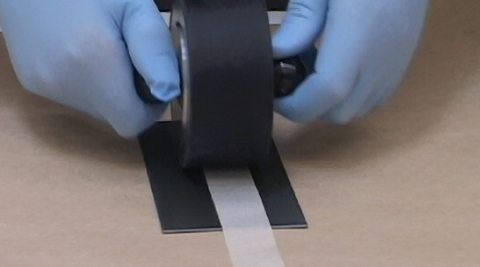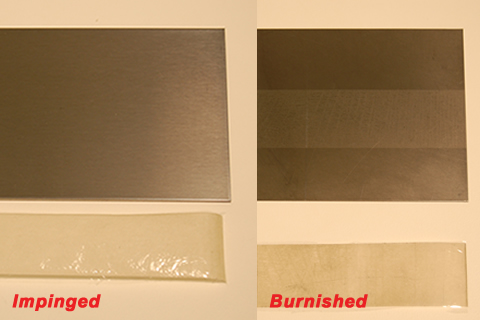SAE AMS 2530
"Tungsten Disulfide Coating, Thin Lubricating Film, Binder-less, Impingement Applied"

Adhesion Test
The Adhesion test is the primary means of testing the quality of Tungsten Disulfide. Our Adhesion test is done weekly and the results are sent out with every order. Please call or stop by if you would like to see the results of our adhesion tests.

Impinged vs. Burnished
Above are the results of a comparison adhesion test between High Velocity Impinged WS2 and the same WS2 applied with a burnishing brush.
Supersedes DOD-L-85645
AMS 2530 is the most recent mill spec for Tungsten Di-sulfide and it supersedes DOD-L-85645
How We Apply AMS 2530
100% Impinged
We have a strict policy of high velocity impinging on every part we process with Tungsten DiSulfide (WS2). There is no other way listed in AMS 2530 that is compliant.
Material
The Tungsten Disulfide used in the process must contain no graphite, molybdenum disulfide, binders or organic material. This prohibits the use of wooden jigs in the application process because it could put organic particles into the powder.
Process
Cleaning -The parts will be cleaned with a procedure capable of removing all polar and non-polar substances including oils and greases as well as any corrosion products and scale/oxide deposits. Here at Applied Tungstenite we use an Ultra Sonic Degreaser with an alkali cleaner to do this for materials not prone to oxidation and non-toxic solvents for materials that are. We also wear gloves at all times when handling the parts after cleaning to prevent re-contamination from skin oils.
Surface Finishing - The parts will be honed with 5 micron aluminum oxide powder to prepare the substrate for coating.
Procedure - "The coating shall be applied to all specified surfaces by spraying at high velocity (impinging) under controlled conditions." The AMS 2530 is very clear. We do not burnish on WS2 or tumble parts.
Testing Methods
Adhesion Test – Tape Adhesion Test
Appearance Test – Microscope Inspection
Thickness Test – Backscatter Method
